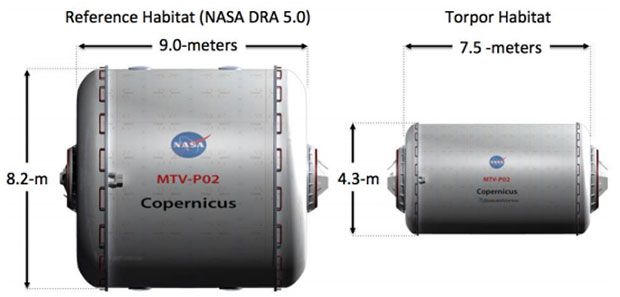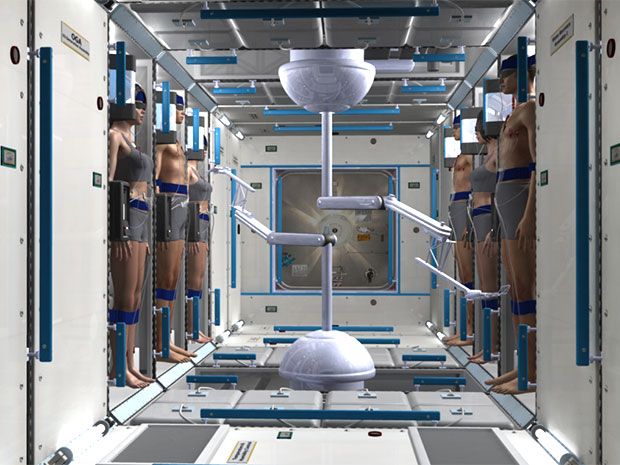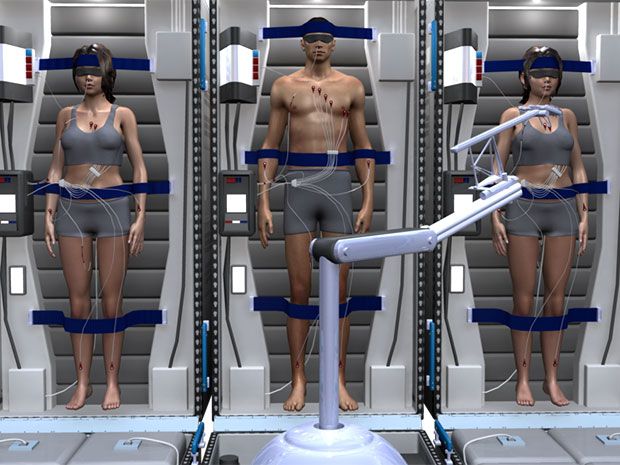Humans are not designed for long-distance travel, which makes the roughly 55 million-kilometer trip to Mars a real hassle. It's hard enough keeping a few of us fleshy weaklings alive next door in low Earth orbit. Now think about a trip to Mars. It’s, at best, several months away, and once you head out, there's no stopping for groceries. The job of the astronauts during the journey will be simple: eat, drink, and breathe the bare minimum necessary for survival, while trying not to die of boredom or kill any of their fellow travelers. After the first few months, it's going to be decidedly unpleasant.
Aerospace company SpaceWorks, with funding from NASA's Innovative Advanced Concepts program, is exploring the idea of having voyagers to Mars do what all professional travelers do when confronted by uncomfortably long transit times: use whatever technologies or pharmaceuticals are available in order to make themselves totally unaware of as much of the experience as possible. A trip to Mars is going to take more than a couple of Ambien, though. That’s why SpaceWorks is working on space habitats that will keep humans comfortably in stasis for the entire trip.
When it says “stasis,” SpaceWorks is talking about putting astronauts in an “inactive, low-metabolic torpor state for mission transit phases.” So, it's not the kind of sci-fi stasis where people are completely frozen and inert (also known as hansoloization), but rather something more akin to hibernation, where the body’s systems just slow way, way down. Fortunately, we know that it's possible to do this, because for many animals, it's a seasonally recurring phenomenon that’s no big deal. What SpaceWorks is trying to figure out is how humans can snooze away for months at a time like bears do.
There are many reasons why putting humans into torpor for long-duration spaceflight is a good idea. One of the biggest is psychological. Spending months in a cramped spacecraft with the same people and nothing new to do or see will be a challenge for even the most disciplined astronauts. And just the thought of the return trip could be super depressing if anything goes wrong.
But the primary reason for torpor, however, is mass. A conscious, active human demands an enormous amount of air, water, and food. And as byproducts of that activity, the body yields liquid and solid waste, poisonous gas, and excess heat—all of which need to be handled within the closed system of an interplanetary spacecraft. We have the technology to do this, but it involves hauling around tons and tons of extra stuff. And when it comes to space travel, extra stuff is usually what you're trying hardest to avoid, because more stuff means more mass, more mass means more engines and more fuel, and all of it together means a staggering increase in cost.
Let's put “staggering” in context. To deliver a crew of six to Mars, NASA estimates that you'd need a habitation module with 380 cubic meters of useful volume, weighing over 28,000 kilograms. On top of that, you'd need 13,000 kg of food. If you instead put that crew of six in torpor, you could shrink the habitation module to 40 cubic meters by throwing out the kitchen, the exercise room, anything entertainment related, eating supplies, and more. And you could trim back the grocery list to just 4,000 kg of food.
This reduction in human-related mass leads to reductions in several areas, including power requirements and the overall structure. The result: The spacecraft can do without 140,000 kg of engines and fuel. This is just over the maximum lifting capacity of the heaviest version of NASA's Space Launch System, which will probably cost something like $5 billion per launch, not including the hardware that it would be carrying.

This cost stuff can be looked at from another perspective, as SpaceWorks points out: If you're going to spend all of this time and money going to Mars, by putting astronauts in torpor, you can send twice as many of them for the same price. This would result in more international participation, and (most importantly) more exploration and science on Mars itself, which is the whole reason we're going.
Getting humans into torpor and keeping them there safely might not, be as science-fictiony as it sounds, SpaceWorks hopes. Humans may not naturally hibernate, but we can fake it for a few days without much trouble. Therapeutic hypothermia is a relatively common medical treatment where hospitals put patients into a sedated hypothermia in the aftermath of a traumatic injury, giving the body a couple of days of healing in a low metabolic state. This is done by cooling the body down (using one of any number of methods, including non-invasive ones) by just five degrees Celsius. This reduces the body’s metabolic rate by between 50 and 70 percent. No drugs are necessary, just the temperature reduction.
Unlike naturally hibernating animals like bears, astronauts aren’t expected to live off of their body fat for eight months. Liquid nutrients can be fed directly into the bloodstream, bypassing the digestive system completely. This technique is called Total Parenteral Nutrition (TPN); it's common for people with gastrointestinal disorders to rely on TPN completely for months or years at a time. A human in torpor would need only about 300 grams of liquid nutrients per day, whereas astronauts on the ISS consume about 2,000 grams of food per day. What’s more, you wouldn't have to worry about solid waste: a simple catheter would take care of everything. Here's what astronauts in a torpor habitat might look like:

So why aren't we doing this already? Mostly, because we haven't tried yet. There's no medical reason for people be kept in low metabolic states through therapeutic hypothermia for more than about five days, so there isn't a lot of data on how to manage longer-term hibernation. SpaceWorks says that they're starting to see limited experimental data for hibernation of up to 14 days. Two weeks is a critical time span. Being able to keep humans in stasis for at least that long makes NASA’s vision start to become viable. Astronauts could be rotated through repeating cycles of activity and hibernation, keeping their consumption, waste, and boredom to a minimum.
SpaceWorks is targeting torpor for the entire trip to Mars, though, and they've got some problems to solve. There are known complications for long-duration intravenous feeding, for example. And it also takes time to safely wake people up, which would be a problem if there's an emergency in the spacecraft or a medical issue. Or, maybe you'd just have robots on hand to manage everything:

Long term, the argument for torpor becomes even more compelling as you start thinking about what it would take to colonize Mars with hundreds of people at a time. SpaceWorks has been toying with the idea of a transfer vehicle capable of hauling 100 passengers to Mars at once using two 48-person torpor modules along with a four person active crew:

Nobody is quite sure exactly what spending months and months in torpor might do to a human—mentally and physically. SpaceWorks is now in Phase II of the NASA-funded research study on the subject. The company will be focusing on medical assessments and evaluations, exploring different approaches for metabolic suppression and nutritional support. Another big unknown they’ll seek to explore: what prolonged hypothermia does to non-hibernating mammals.
Prolonged microgravity might also be an issue, but SpaceWorks is exploring ways of spinning their stasis habitat to generate artificial gravity—a move that conscious astronauts wouldn’t be to handle—as well as using direct electrical stimulation to keep muscle mass from decreasing.
At the same time, SpaceWorks is thinking much farther ahead, to what would come next, after Mars. The ability to put humans in torpor indefinitely would potentially open up the asteroid belt and both Jupiter and Saturn to human exploration.
Quelle: IEEE

